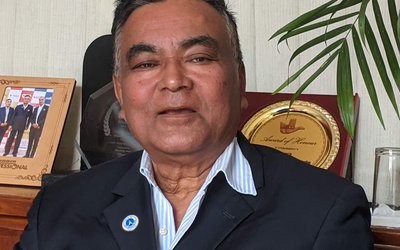How do you look at the recent international conference you attended here?
Well. It is good to be here and see people working in the areas of climate change and livelihood.
How is your project linked with the international conference?
We are part of this conference because we came here to present the value of the datasets that provide information on ecosystem and economy, relating them to power generation in Nepal’s river basins. Our project was conceived at a high level, by the NASA administrator. It is a collaboration between the City College of New York and Urban National Lab of Chicago.
What does your project do?
We are doing research using the NASA datasets to look at the climate change processes in the high mountains in Asia, linking them with economic values and how all this affects people’s lives in particular. My colleague Shruti is doing work from the Department of Energy and her work is related to the effects of climate change on fisheries and generation of hydropower. We are interested in studying the ecosystems and the economy of power generation. Through NASA satellites, we can observe the impacts of climate change on those issues.
Who is your local partner here?
Our local partner is the Kathmandu University (KU), which is working with us. The KU has been collecting data in the Trishuli basin through its own station. We are going to have a detailed economic valuation under that dataset. The person, who has been doing the research, has a long history.
How is the NASA dataset used?
We are using the NASA dataset by observing the entire country and providing the dataset for the larger high mountain Asia team that NASA has put together. And then, our piece of the study, examining a particular basin region, looks at the fishery and power generation.
Will it cover the region?
It is at the regional level, with a retrospective outlook, extending from the year 2000 till the present and then the projection of climate change effects into the future, looking up to fifty to hundred years.
What does your preliminary study say?
We have just started the research. We don’t have any results yet. Some of our preliminary results will be presented in Alaska in coming May. We are going to present some of the early work. We have been working with this satellite data for so many years, adopting these techniques, focusing in areas like Alaska, Canada and the larger Pacific Arctic Region, but this is our first opportunity to have a project to use this kind of observation in high mountains of Asia.
How are you going to be working with this data?
We are very excited to start some of the historical work, as we have done with the NASA data in the context of effects of climate change on people’s lives, particularly in Nepal, because it is the region quite vulnerable to climate change. We have seen the effects in Alaska and we have been studying the same kind of seasonal change we saw in Alaska.
What changes do you expect to see?
We expect to see the change in length of winter and summer as the summer time is getting longer and the winter time is getting shorter. Changes in parameters relate to the snow and glacier fields. We are interested in these changes. An interesting part of this particular study is going to be connecting those changes, which are climate driven, into the economy and how people’s lives are being affected by this, particularly, in Nepal.
What is the stated purpose of the project?
This is a NASA Project. NASA has developed this to look at the climate change effects in high mountain Asia. With City College, Department of Energy in Urban National Lab is particularly looking at the effect of climate linkages at the snow melt in glacial hydrology and how that affects the river flow and how that relates to fisheries and to the power generation through hydropower plants. This is a collaboration between the City College of New York and Urban National Lab and NASA and Kathmandu University is our local partner.
How important is this work?
I want to reiterate that this is one project that NASA has developed in order to bring a team of world class scientists to look at the effects of climate change in the high mountain Asia. There are other projects looking at other aspects like landslides and risk factors and effects on people's lives. Our study is rather unique in its technique of using the remote sensing through the model, trying to link it with hydropower and fisheries.

Keshab Poudel
Poudel is the editor of New Spotlight Magazine.
- FM Dr. Deuba’s India Visit: Mission Aborted
- Mar 26, 2025
- AMBASSADOR MAEDA TORU: Warm Regards
- Mar 24, 2025
- PRO-MONARCHY MOVEMENT: Rising Dissatisfaction
- Mar 23, 2025
- Dr. PRABIN MANANDHAR: Person With Humility
- Mar 16, 2025
- US SUSPESION OF GRANT: Impact On Nepal
- Mar 10, 2025















